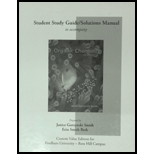
Concept explainers
Draw the products of each reaction, and indicate the stereochemistry where appropriate.
a.  f
f
b g.
g. 
c.  h.
h. 
d. ![]() i.
i. 
e.  j.
j. 
(a)
Interpretation: The product of the given reaction is to be drawn including stereochemistry if appropriate.
Concept introduction: Alkyl tosylates undergo elimination reaction when they are allowed to react with strong nucleophilic base. The mechanism of the elimination reaction is
Answer to Problem 9.71P
The product of the given reaction is,

Figure 2
Explanation of Solution
The given reaction involves treatment of alkyl tosylate with
Alkyl tosylates undergo elimination reaction when they are allowed to react with strong nucleophilic base. The mechanism of the reaction is
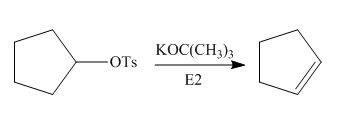
Figure 1
Thus, the product of the given reaction is,

Figure 2
The product of the given reaction is drawn in Figure 2.
(b)
Interpretation: The product of the given reaction is to be drawn including stereochemistry if appropriate.
Concept introduction: The reaction of alcohols with halogen acids
Answer to Problem 9.71P
The product of the given reaction is,

Figure 4
Explanation of Solution
The given reaction involves treatment of an alcohol with
The reaction of alcohols with halogen acids
The corresponding reaction is shown below.

Figure 3
Thus, the product of the given reaction is,

Figure 4
The product of the given reaction is drawn in Figure 4.
(c)
Interpretation: The product of the given reaction is to be drawn including stereochemistry if appropriate.
Concept introduction: The opening of an epoxide/ethylene oxide ring is regioselective either it takes place with a strong nucleophile
Answer to Problem 9.71P
The product of the given reaction is,
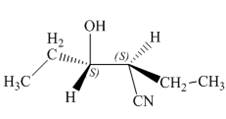
Explanation of Solution
The given reaction involves treatment of epoxide ring with cyanide ion.
In the given reaction,
The corresponding reaction is shown below.

Figure 5
Thus, the product of the given reaction is,

Figure 6
The product of the given reaction is drawn in Figure 6.
(d)
Interpretation: The product of the given reaction is to be drawn including stereochemistry if appropriate.
Concept introduction: The
Answer to Problem 9.71P
The product of the given reaction is,

Figure 8
Explanation of Solution
The given reaction involves treatment of alkyl tosylate with
The

Figure 7
Thus, the product of the given reaction is,

Figure 8
The product of the given reaction is drawn in Figure 8.
(e)
Interpretation: The product of the given reaction is to be drawn including stereochemistry if appropriate.
Concept introduction: Alkyl bromides are obtained by the reaction of
Answer to Problem 9.71P
The product of the given reaction is,
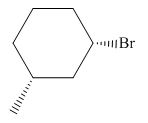
Figure 10
Explanation of Solution
The given reaction involves treatment of secondary alcohol with
Alkyl bromides are obtained by the reaction of

Figure 9
Thus, the product of the given reaction is,

Figure 10
The product of the given reaction is drawn in Figure 10.
(f)
Interpretation: The product of the given reaction is to be drawn including stereochemistry if appropriate.
Concept introduction: Alcohols are converted into alkyl tosylates by treatment with
Answer to Problem 9.71P
The product of the given reaction is,

Figure 12
Explanation of Solution
The given reaction involves treatment of an alcohol with
Alcohols are converted into alkyl tosylates by treatment with
 Figure 11
Figure 11
Thus, the product of the given reaction is,

Figure 12
The product of the given reaction is drawn in Figure 12.
(g)
Interpretation: The product of the given reaction is to be drawn including stereochemistry if appropriate.
Concept introduction: The opening of an epoxide/ethylene oxide ring is regioselective either it takes place with a strong nucleophile
Answer to Problem 9.71P
The product of the given reaction is,
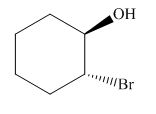
Figure 14
Explanation of Solution
The give reaction involves treatment of an epoxide with halogen acid
The opening of an epoxide/ethylene oxide ring is regioselective either it takes place with a strong nucleophile
The corresponding reaction is shown below.

Figure 13
Thus, the product of the given reaction is,

Figure 14
The product of the given reaction is drawn in Figure 14.
(h)
Interpretation: The product of the given reaction is to be drawn including stereochemistry if appropriate.
Concept introduction: The opening of an epoxide/ethylene oxide ring is regioselective either it takes place with a strong nucleophile
Answer to Problem 9.71P
The product of the given reaction is,
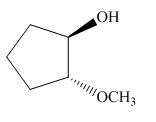
Figure 16
Explanation of Solution
The give reaction involves treatment of an epoxide with
The opening of an epoxide/ethylene oxide ring is regioselective either it takes place with a strong nucleophile
The corresponding reaction is shown below.

Figure 15
Thus, the product of the given reaction is,

Figure 16
The product of the given reaction is drawn in Figure 16.
(i)
Interpretation: The product of the given reaction is to be drawn including stereochemistry if appropriate.
Concept introduction: Ethers are the most common organic products of nucleophilic substitution reaction. They are prepared from alkyl halides and strong nucleophiles. The reaction proceeds through
Answer to Problem 9.71P
The product of the given reaction is,
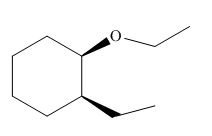
Figure 18
Explanation of Solution
The given reaction involves treatment of a
The alkoxide salts are prepared from alcohols through the Bronsted-Lowry acid-base reaction. In this reaction,
The obtained alkoxide from this reaction contains
The corresponding reaction is shown below.

Figure 17
Thus, the product of the given reaction is,
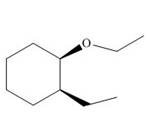
Figure 18
The product of the given reaction is drawn in Figure 18.
(j)
Interpretation: The product of the given reaction is to be drawn including stereochemistry if appropriate.
Concept introduction: Ethers react with strong acids, (only
In this reaction, both
Answer to Problem 9.71P
The product of the given reaction is,

Figure 20
Explanation of Solution
The given reaction involves treatment of an ether with two equivalents of
Ethers react with strong acids, (only
In this reaction, both
The corresponding reaction is shown below.

Figure 19
Thus, the product of the given reaction is,

Figure 20
The product of the given reaction is drawn in Figure 20.
Want to see more full solutions like this?
Chapter 9 Solutions
Organic Chemistry -Study Guide / Solution Manual (Custom)
- Draw the products of each reaction, and include the stereochemistry at any stereogenic center in the products (d.)arrow_forwardWhich two reagents woyld react to produce the given product? The correct answer is A but please explain why.arrow_forwardDevise a synthesis of attached compound from cyclohex-2-enone andorganic halides having one or two carbons. You may use any otherrequired inorganic reagents.arrow_forward
- Devise a synthesis of X from the given starting materials. You may useany organic or inorganic reagents. Account for the stereochemistryobserved in X.arrow_forwardDraw the products (including stereochemistry) for each reaction.arrow_forwardDraw the major organic product of the reaction. Ignore stereochemistryarrow_forward

 Organic ChemistryChemistryISBN:9781305580350Author:William H. Brown, Brent L. Iverson, Eric Anslyn, Christopher S. FootePublisher:Cengage Learning
Organic ChemistryChemistryISBN:9781305580350Author:William H. Brown, Brent L. Iverson, Eric Anslyn, Christopher S. FootePublisher:Cengage Learning

